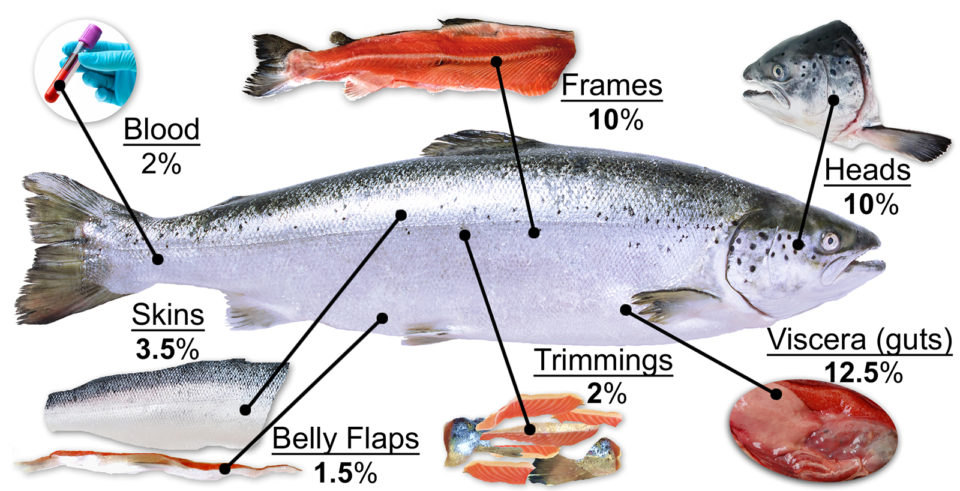Julien Stevens: Fish byproducts are an under-valued and untapped resource

If you’d told me five years ago that I would be spending a significant portion of the coming years researching seafood byproducts such as fish heads, guts and skins, I probably would have laughed at the proposition.
Yet I’ve discovered that fish byproducts are one of the industry’s few under-valued and un-tapped resources. By maximizing the use of byproducts, we can produce more food and revenue without using more feed resources. Which is pretty great, especially considering that, around the globe, fish byproducts represent millions of tons of resources.
This research interest developed during my master’s degree at the University of Stirling, in Scotland, where an aquaculture nutrition expert told me, “You will likely find more omega-3 fatty acid in the guts of the salmon than in the fillet.”
Recognizing the value of these heart-healthy omega-3 ingredients and having a keen interest in responsible resource use, I ended up framing my master’s research around how the Scottish salmon industry was using their byproducts.
After pouring through the available information on this topic in the United Kingdom, I realized there wasn’t much out there and much of it was outdated. From a sustainability perspective, most of the aquaculture industry’s attention has been placed on the fish in:fish out conundrum at the upstream end of the value chain, and I was surprised at how little dialogue there was on the downstream implications.
This research has the potential to advance the sustainability of the industry as a whole.
With byproducts representing anywhere from 25 to 50 percent of the weight of various fish species, I felt we needed to be looking at how the entire fish was being used. I was fortunate to find likeminded researchers at the University of Stirling and the University of Massachusetts at Boston, and to receive funding from IFFO-The Marine Ingredients Organisation.
It took a bit of convincing to get all the producers and processors on board with sharing their data, but they soon realized this research had the potential to advance the sustainability of the industry as a whole, and that’s something they could all get behind. Once we had all the data some interesting findings emerged.
To start with, it was great to see that in Scotland, byproducts from salmon farming are generally well utilized. Yet the data showed that the total byproduct value output could be improved by 803 percent (£23.7 million), based on the 2015 figures, adding 5.5 percent value to the salmon industry.
We found that this could be achieved through a more strategic use of the industry’s byproducts, for example, taking all high-value byproduct types (heads, frames, trimmings and belly flaps) and directing them towards domestic and export food markets rather than to lower value uses, such as animal feed.
These findings were supported by our nutritional analysis that identified all of the tested by-product types, not just the guts, contained more omega-3 fatty acids than the fillet. The findings also showed the importance of proper sorting, storage and transport of byproducts after processing, and suggested that investment in this area as the industry grows could lead to some great benefits.
Through seeing byproducts in this new light, as a valuable resource, and managing them more strategically, we can make better use of what we already produce. For me, that’s what responsible aquaculture production looks like.
To read Julien Stevens’ recent research paper into seafood byproducts, “The rise of aquaculture byproducts: Increasing food production, value and sustainability through strategic utilization,” please click here.
Author
-

Julien Stevens
MSc, Sustainable Aquaculture
Related Posts

Aquafeeds
Aquaculture Exchange: Andrew Jackson, IFFO
Aquaculture remains dependent on fishmeal and fish oil, crucial marine ingredients in aquafeeds, particularly at key life stages. Andrew Jackson, technical director at IFFO and one of the world’s foremost fishmeal experts, tells the Advocate that the two industries can coexist well into the future if properly managed.

Aquafeeds
Aquaculture’s input efficiency shines as FIFO ratios improve
The latest Fish In:Fish Out (FIFO) ratios calculated by IFFO – The Marine Ingredients Organisation shows that every kilogram of wild fish utilized in aquafeeds results in a total of 4.55 kilos of farmed fish produced.

Aquafeeds
Bridging the omega-3 gap with methane, microalgae
Innovation is leading to new ingredient options for renewable sources of omega-3 fatty acids. But Replicating long chain fatty acids is a tall order, Advocate contributor Lisa Duchene discovered.

Aquafeeds
Omega-3 levels fall in farmed salmon but it’s still a top source
Reformulating aquaculture feeds, an industrywide initiative to reduce dependence on wild fish, has changed farmed salmon’s nutritional profile, as BBC News reported recently. The researchers on whose work the report was based say of course it has, yet it remains one of the best sources for these crucial fatty acids.

